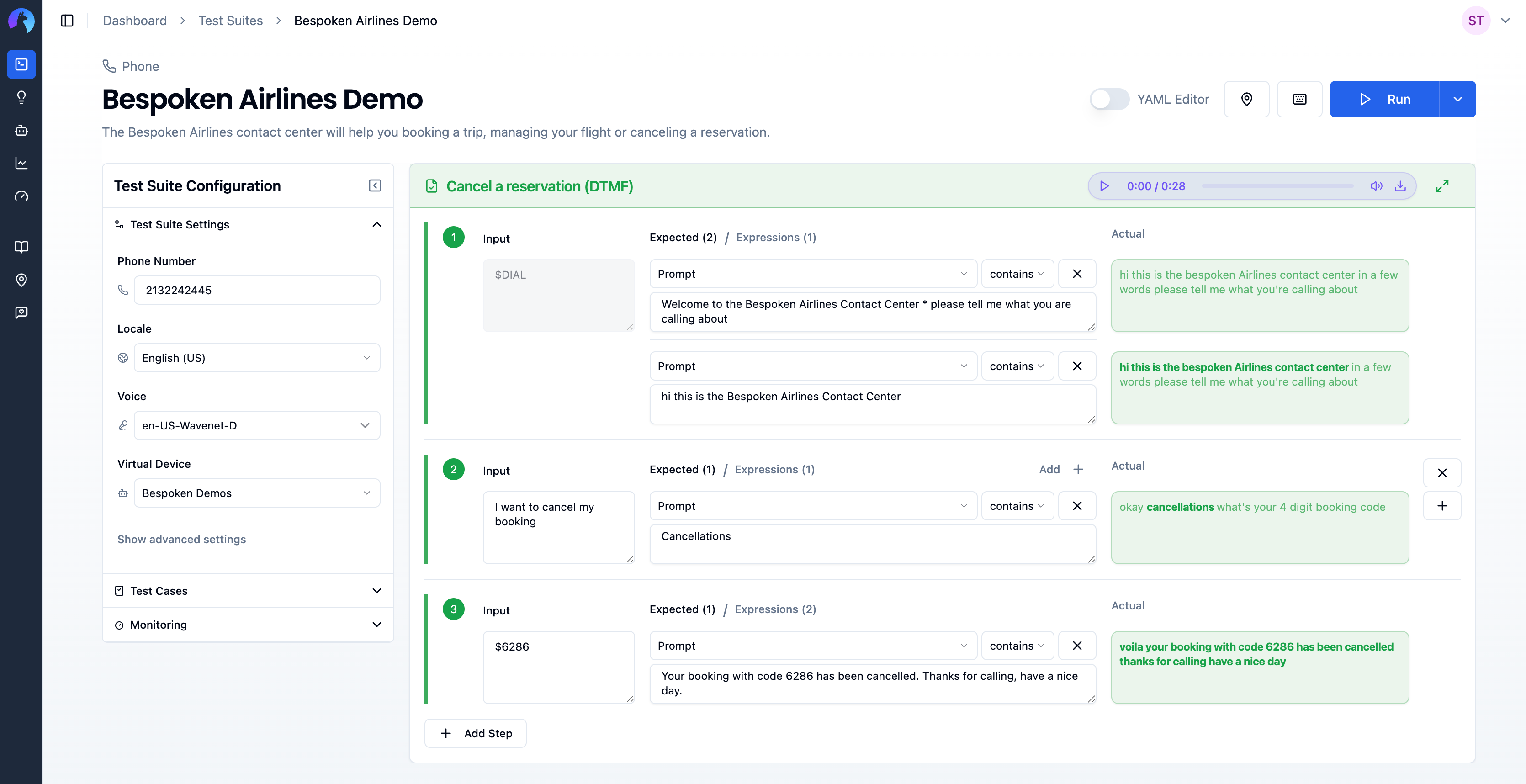# Functional Testing for Interactive Voice Response Systems
We provide support for Interactive Voice Response (IVR) and Intelligent Virtual Agent (IVA) systems by simulating real user interactions. This involves placing a call and interacting with your system using voice and DTMF inputs.
Important
In this guide, we'll cover the specifics of testing IVR systems. For common concepts on how to test with Bespoken, refer to the Test Page article in the Dashboard section. We highly recommend reading that first.
# Approach
Consider the following excerpt from a call made to an airline company's IVR system:

Unlike other conversational platforms, where communication happens in turns, an IVR call occurs over a bi-directional line where both parties can speak at any time. Therefore, it's crucial to identify key moments during the call to translate them correctly into a test. From the caller's perspective, the key moments in the call are:
- Dialing the airline's number
- Identifying when it's our turn to talk ("tell me what you're calling about")
- Responding with our intention
- Pressing a number on the phone keypad if necessary
- Repeating a step if the IVR system does not understand us
Here's the same call represented as a Bespoken test:

In this test:
- We call the configured number and start transcribing the call in real-time.
- We expect to hear "Hi! This is the Bespoken airlines contact center. In a few words, please tell me what you're calling about."
- We say "Cancellations" after hearing "tell me what you are calling about."
- We press
6286on our keypad after hearing "4 digit booking code." - We expect to hear "Your booking with code 6286 has been canceled. Thanks for calling, have a nice day!"
The keywords corresponding to these key moments in a conversation are: $DIAL, finishOnPhrase, and $<NUMBER>. These are the most common keywords you'll need to get familiar with, and we'll explain these and other options below.
# Configuration
The main configuration for an IVR test consists of the following:
| Property | Description | Default |
|---|---|---|
| Locale | The language in which the system is being tested. Used for real-time transcription and text-to-speech conversion. | en-US |
| Voice | The voice to use when speaking on the call. Options include voices from Amazon Polly, Google Text-to-Speech, and IBM Watson. | Joey |
| Phone number | The phone number to call in your test. | N/A |
| Virtual Device | The virtual device to use in your test. A default device is already included in your account. | Default device |
# Input Configuration
In the input field, any text will be converted into audio and played during the call. However, there are other accepted keywords in this field:
$DIALRepresents picking up the phone and calling the configured number. It is the first input in any IVR test.$<NUMBER>Represents a DTMF input. For example, $1 when prompted to press 1. Longer numbers are also accepted.
Additionally, you have the option to enter SSML directly into this field to further customize an utterance. For example:
<speak>Hello, <break time="1s"/> how are you today?</speak>
would take a 1-second pause after the word "Hello," while
<speak>Hello, how are <emphasis level="strong">you</emphasis> today?</speak>
would put a strong emphasis on "you." You can learn more about SSML here (opens new window).
Finally, you can also use prerecorded audio simply by entering a WAV or MP3 file URL in the input field.
Combined inputs
If you need to press a star * or pound # symbol after a utterance, simply put it at the end of the input. For example: John Doe * will say John Doe with the current voice and then press star at the end.
# Expected Configuration
The main expected property Prompt will be compared against the transcription of what we hear from your IVR system, as explained previously here.
For IVR calls, we also support evaluating the following values for the last interaction of the call:
| Property | Description | Default |
|---|---|---|
Connection End Time | Specifies the date and time in which the call ended. | N/A |
Connection Ended By | Determines who ended the call possible values are caller and callee | N/A |
# Expressions
Expressions will modify the behavior of the current interaction. These properties can be added on the "Expressions" tab at the test step level and are all optional:
| Property | Description | Default |
|---|---|---|
Finish on Phrase | Ends the current interaction and moves to the next when this phrase is heard. | Last portion of the current Prompt |
Listening Timeout | Ends the current interaction and moves to the next after this many seconds. | 45 seconds |
End Speech Timeout | Ends the current interaction and moves to the next after this many seconds of silence are heard. | N/A |
Pause Before Utterance | Adds this many seconds of silence before the utterance. | N/A |
Repeat on Phrase | Repeats the current utterance if this phrase is heard. Example: "sorry I didn't get that." | N/A |
# Advanced Settings
In addition to the common advanced settings, the following parameters are exclusive to IVR testing:
| Property | Description | Default |
|---|---|---|
| Record call | When enabled, records the call, making it available for listening after the test run. | true |
| "Repeat on" phrases | Repeats the current utterance if one of these phrases is found. Useful when the system does not understand what was said. | N/A |
| Speech-to-Text model | Specifies the machine-learning model used to transcribe the call audio. This can improve transcription accuracy depending on the audio source. Note: not all models support all languages. Learn more about it here (opens new window). | Phone call |
| Homophones | Lists values that will be replaced by their key when found to help with speech recognition. For example, "There" vs. "Their" vs. "They're". Separate values with commas. | N/A |
| Pause before utterance | Number of seconds of silence before playing an utterance. | 0 |
| Finish on phrase fuzzy threshold | A decimal from 0 to 1 that sets the threshold for fuzzy matching to identify a finishOnPhrase value. A value of 1 means the phrases must match exactly. | 0.9 |
| End of speech timeout | Time in seconds of silence to wait before moving to the next interaction. | N/A |
